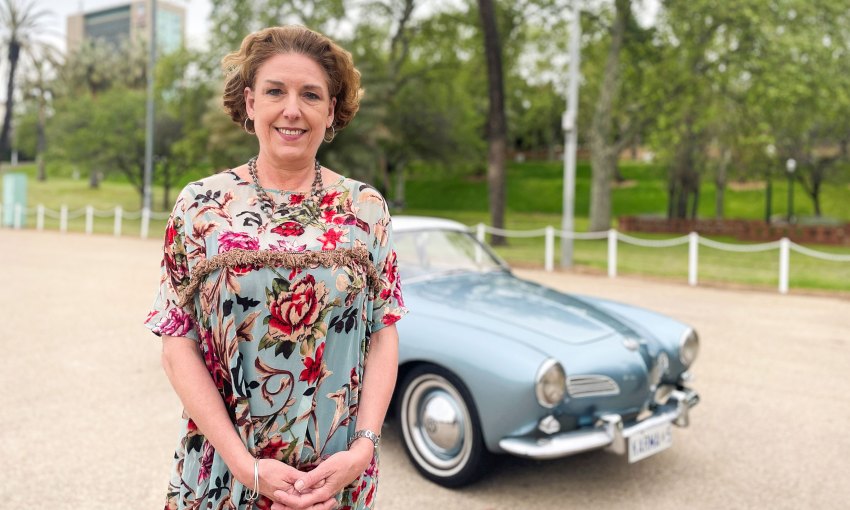Laura Kroetsch has spent most of her life surrounded by books and has never owned or driven a vehicle. But working on the Bay to Birdwood has given her new appreciation for cars – especially those that embody stories from days gone by.
From books to bonnets – car bonnets
The first time I walked into the National Motor Museum in Birdwood, I did not like the smell. No nostalgia for me, just an acrid odour, a servo and a lot of stuff.
I have spent the better part of two decades making literary and ideas festivals. As such, I have put people on stage to talk about their ideas, their work, and their thoughts. These encounters are live, unscripted, and until recently utterly ephemeral (these days everything is recorded).
Working in live events had me convinced that I had not yet considered the world of material culture. A strange madness, as I own several thousand books but little else – no white goods, little furniture, no car, not even a bicycle.
Just shy of six months ago, I started work at the History Trust of South Australia. As museums are the portfolio, it has been a short sharp dive into material culture and event-making as I now manage the Bay to Birdwood.
My ignorance of material culture is disingenuous, as I have dragged my books around the world. I keep them as a chronicle of my life; they are memories of my childhood, my parents, of places I have lived and people I have loved. They are cumbersome, of no real monetary value, have few duel purposes and are, like all things, quietly wasting away.
The same is, of course, true for any object we decide to keep and care for, including cars (or vehicles, as I have learned to say). Like books, technology has not been kind to the automobile – think e-readers and in-built computer systems. Convenient, but somehow lesser than the earlier models. So for various types of value we look back into the past.
Vehicles, like books, are a marvel of human engineering. The best of them are relics, objects that have survived from an earlier time, and as such, objects to be revered. They contain stories of engineering, ambition, innovation, desire and disuse, obsolesce and lost skills. They are what managed to be saved and restored or preserved by the individuals who love them. They are, like all objects, forever ending, so care is ongoing.
The Bay to Birdwood is an exercise in historic preservation. It is a celebration of design, and it is an epic journey.
The motorcar is ubiquitous, like the book, and therefore easy to overlook. We rely on specialists to care for vehicles and to act as interpreters, explaining to us why one is more “valuable” than another. I came into my current job blissfully ignorant of vehicles, of what they mean to the individual or to the culture at large. I have never owned one and I do not drive.
Like books, vehicles are associated with certain sorts of people – books with the intelligentsia and cars with the working class. It is nonsense, as my boss likes to say – everyone has a car story. And the old ones cost a bomb, so they require a certain level of privilege to actually own. And yes, there are more copies of Dan Brown in this world than perhaps should be allowed, and people read them, just like muscle cars or whatever you care to dismiss.
I am, by birth, American, and our love of the open road is legendary – Route 66, pop songs, the invention of the motel, cars without air-conditioning, and movies, lots of movies. Americans love few things the way we love locomotion – so much so that many of our streets lack sidewalks.
A similar condition is found here. The history of Australia is particularly reliant on horses, carriages, steam, electric and combustion engines – it’s a big place. One that has its own troubled relationship with Manifest destiny.
Having given it some thought, and listened to my betters, I have, if not fallen in love, at least gained a real appreciation for the historical vehicle. They are beautiful, often difficult to drive, and lack safety features and cooling systems. Forty years ago in Adelaide there was no Sunday trading, fewer cars on the road and all of four street lights between West Beach and Birdwood (today we have 39).
The Bay to Birdwood is an exercise in historic preservation. It is a celebration of design, and it is an epic journey. You can stand on the side of the road and watch the parade pass. You can make your way up to Birdwood and wander among the vehicles, talk to their owners, discover their stories. It is a good way to spend a spring day – certainly as good as reading a book.
The Bay to Birdwood is on this Sunday, October 16.
Laura Kroetsch is events manager at the History Trust of South Australia. She is a former director of Adelaide Writers’ Week and has previously held roles with Tasmania’s Dark Mofo and OzAsia’s JLF Adelaide .



